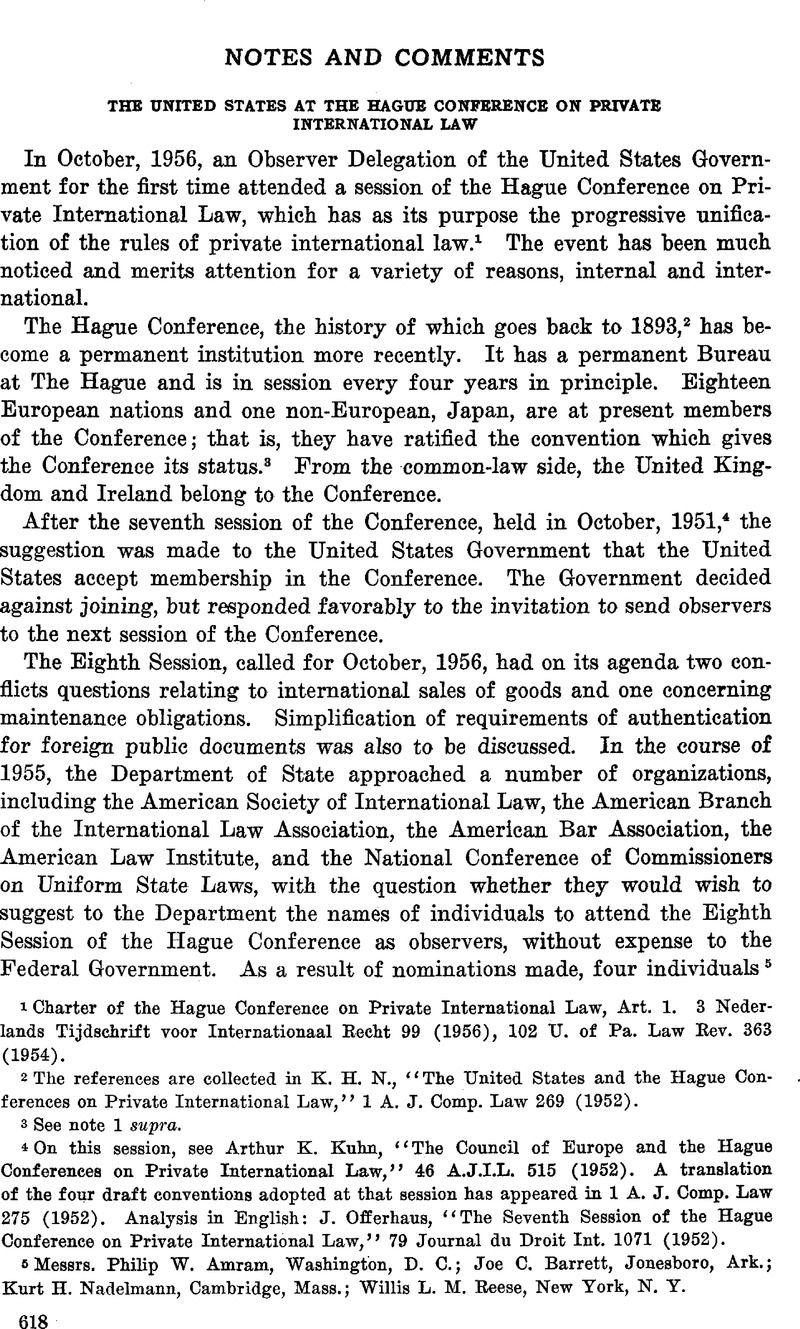No CrossRef data available.
Article contents
The United States at the Hague Conference on Private International Law
Published online by Cambridge University Press: 28 March 2017
Abstract

- Type
- Notes and Comments
- Information
- Copyright
- Copyright © American Society of International Law 1957
References
1 Charter of the Hague Conference on Private International Law, Art. 1. 3 Nederlands Tijdschrift voor Internationaal Recht 99 (1956), 102 U. of Pa. Law Rev. 363 (1954).
2 The references are collected in , K. H. N., “The United States and the Hague Conferences on Private International Law,” 1 A. J. Comp. Law 269 (1952).Google Scholar
3 See note 1 supra.
4 On this session, see Kuhn, Arthur K., “The Council of Europe and the Hague Conferences on Private International Law,” 46 A.J.I.L. 515 (1952).Google Scholar A translation of the four draft conventions adopted at that session has appeared in 1 A. J. Comp. Law 275 (1952). Analysis in English: Offerhaus, J., “The Seventh Session of the Hague Conference on Private International Law,” 79 Journal du Droit Int. 1071 (1952).Google Scholar
5 Messrs. Philip W. Amram, Washington, D. C.; Joe C. Barrett, Jonesboro, Ark.; Kurt H. Nadelmann, Cambridge, Mass.; Willis L. M. Reese, New York, N. Y.
6 Text of the Final Act, with the conventions, in 45 Revue Critique de Droit International Privé 746, and 39 Rivista di Diritto Internazionale 425 (1956). English translation of the conventions in 5 A. J. Comp. Law, No. 4 (1956).
7 See Final Act, cited supra.
8 List in van Hoogstraten, M. H., “Quelques notes sur la Conférenee de La Haye de droit international privé (IV),” 3 Nederlands Tijdschrift voor Internationaal Recht 307, 314 (1956).Google Scholar
9 See Actes de la Huitième Session de la Conférence de La Haye de Droit International Privé (1957), sessions of Oct. 18 and 19, 1956, of Commission IV, Documents (1957).
10 See Nadelmann, Kurt H. and Reese, Willis L. M., “The Eighth Session of the Hague Conference on Private International Law,” 12 The Record of the Association of the Bar of the City of New York 51 (1957)Google Scholar, and forthcoming reports by Messrs. Philip W. Amram and Joe C. Barrett in the American Bar Association Journal and the Handbook of the National Conference of Commissioners on Uniform State Laws, respectively.
11 Even in the civil law countries, a general codification of the rules of conflict of laws is opposed by many. See, e.g., the discussion on codification in the French Committee on Private International Law, Paris, May 20–21, 1955: Comité Français de Droit International Privé, La Codification du Droit International Privé 298 (1956).
12 The Uniform Commercial Code, sec. 1–105 (6), deals with the related question of selection of the law to govern the transaction. Recent cases in Federal courts on selection of a forum: Wm. H. Muller & Co. v. Swedish American Line, Ltd., 224 F. 2d 806 (2d Cir., 1955), 31 N. Y. U. Law Rev. 949 (1956); Siegelman v. Cunard White Star, 221 F. 2d 189 (2d Cir., 1955). Cf. Restatement Second, Conflict of Laws § 117a (Tent. Draft No. 4, 1957) (“fair and reasonable” test).
13 The history is in Nadelmann, Kurt H., “Ignored State Interests: The Federal Government and International Efforts to Unify Rules of Private Law,” 102 U. of Pa. Law Rev. 323 (1954).CrossRefGoogle Scholar Cf. Hynning, Clifford J., “International Law: Unification of Private Property Laws,” 42 A. B. A. Journal 1135 (1956).Google Scholar
14 See Contini, “The United Nations Convention on the Recovery Abroad of Maintenance,” 31 St. John’s Law Rev. 1 (1956).Google Scholar
15 See Record of the U. N. Conference on Maintenance Obligations, Docs. E/Conf. 2/SR. 1 to 14 (1956).
16 One of the assignments is study of the possibility of revision of the Bustamante Code on Private International Law in the light of the Montevideo treaties and the Restatement of Conflict of Laws. See Kurt H. Nadelmann, loc. cit. note 13 supra, at 344; [1952–54] Inter-American Juridical Yearbook 169, 271, 297 (1955).
16a But see Presidential Address, [1956] Handbook of the National Conference of Commissioners on Uniform State Laws 42, 50.
17 See Report for 1953–54 of the Committee on Private International Law, Elliott E. Cheatham, Chairman, [1954] Proceedings and Committee Reports of the American Branch of the International Law Association 30–35, 78 (1954).
18 On co-operation with the International Institute for the Unification of Private Law in Rome, see Nadelmann, Kurt H., “Unification of Private Law,” 29 Tulane Law Rev. 328 (1955).Google Scholar
19 In Canada, the Dominion Government is a member of the Conference of Commissioners on Uniformity of Legislation in Canada. This has proved advantageous especially in work on uniform laws designed to be used on the international as well as the inter-Provincial level. An example is the preparation of the new Reciprocal Enforcement of Judgments Act, [1956] Proceedings of the Conference of Commissioners on Uniformity of Legislation in Canada 82. See Nadelmann, Kurt H., “Non-Recognition of American Money Judgments Abroad and What to Do About It,” 42 Iowa Law Rev. 236, 248 (1957).Google Scholar
20 U. S. Constitution, Art. I, Sec. 8, cl. 3.
21 Notice the plan, in a related area, to set up a Commission and Advisory Committee to improve judicial co-operation between the United States and foreign countries. Jones, Harry LeRoy, “A Commission and Advisory Committee on International Rules of Judicial Procedure,” 49 A.J.I.L. 379 (1955).Google Scholar See H. R. 4642, S. 1890, 85th Cong., 1st Sess. (1957). 1 Int. & Comp. Law Bulletin 6 (1957).


